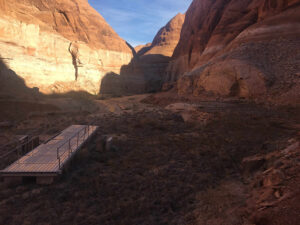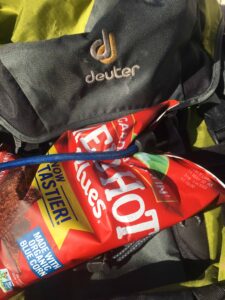 Slickrock domes and washes of cream-colored sand, groves of tall pinon, blackbrush meadows—the long trail to Rainbow Bridge had not changed much, as far as I could tell, in the intervening more than 30 years. Not that I remembered it in much detail. When I first visited the place I was a newbie to the Southwest, gobsmacked by the scale of mountains and plains, in love with the sensations of experiencing new landscapes. But I had few of the tools needed to understand them, like swelling familiarity with maps, a comprehension of geology or ecology, or simple exposure to the stories others told about them.
Slickrock domes and washes of cream-colored sand, groves of tall pinon, blackbrush meadows—the long trail to Rainbow Bridge had not changed much, as far as I could tell, in the intervening more than 30 years. Not that I remembered it in much detail. When I first visited the place I was a newbie to the Southwest, gobsmacked by the scale of mountains and plains, in love with the sensations of experiencing new landscapes. But I had few of the tools needed to understand them, like swelling familiarity with maps, a comprehension of geology or ecology, or simple exposure to the stories others told about them.
What I did remember, though, was that I copied the brilliant idea a friend had of strapping a bag of Red Hot Blues corn chips to the outside of his backpack. For a suburban midwestern kid raised in part on the mainstream junk foods of Doritos and Pop-Tarts, the organic chips were themselves a revelation, an organic and tasty marker of tribal identity as accurate as Patagonia fleece jackets and Teva sandals. And so what I remember of the beginning of that long-ago hike is not just how the springtime desert was not hot or red at all, but rather blue in the wake of a clearing storm, with a dense smell of sage wafting everywhere—another sensation new to me—but also the distinct thwack a bungee cord makes when you use it to strap a plastic bag of chips onto a backpack just before setting out.
 It’s funny the way memory works, chopping the continuous skein of existence into disconnected fragments that rest like coins in the safe deposit box where we keep the treasures of our past. I can round up those fragments from April 1990, the smell of sage, the cloudy spring sky, the look of bootprints on a muddy but drying trail, the body memory of rolling out my sleeping bag in a sandstone alcove in Bridge Canyon. I rub them together, trying to create a whole experience while knowing that too much handling probably changes them forever.
It’s funny the way memory works, chopping the continuous skein of existence into disconnected fragments that rest like coins in the safe deposit box where we keep the treasures of our past. I can round up those fragments from April 1990, the smell of sage, the cloudy spring sky, the look of bootprints on a muddy but drying trail, the body memory of rolling out my sleeping bag in a sandstone alcove in Bridge Canyon. I rub them together, trying to create a whole experience while knowing that too much handling probably changes them forever.
But other fragments slip clear definition, like the real reason I was so unfocused on the details of trail and landscape all those years ago. This was the presence of one of the other members of our group, a beautiful young woman whose gait and smile and eyes I can still recall vividly. Yes, I was in love, but our group backpacking trip came at just the time when I was realizing that the strength of my feelings was not enough to get me what I wanted. I was a friend, no more. And so I spent much of the hike in one of the most continent’s most beautiful places in a sort of daze, jockeying for position next to her on the trail, jealous of the attentions of others. If what I wanted was red hot, all I was coming away with was the blues.
Thirty-some years later our group is made up of friends mainly my age, some I’ve known a long time, some I’ve just met. We’ve been through some storms, some worse than my lovelorn train funk back then. The weather is oddly similar, as a winter storm has just cleared away, leaving white clots of snow in the blackbrush, puddles on the trail. And it’s cold as we make our way the first day to our camp at Surprise Valley.
I guess a benefit of the way memory works at times so inefficiently is that I can almost say I was seeing the place for the first time. The hidden slickrock canyons slicing down from the snow-covered flanks of Navajo Mountain, the maze of red sandstone in the distance all the way to the Colorado River and beyond, even the spectacular bridge itself: had I really seen them before? Maybe not really seen them. This time, I tried to commit as much as I could to memory—not the easy memory of photos, but intensive looks at the landscape, trying to imprint patterns into my brain.
This, though, I did remember from that long-ago trip: in 1990, a couple of friends and I walked down from the bridge to the dock that marked the edge of Lake Powell. This was a couple minutes’ stroll that left us within sight of the natural bridge. Back then, the great reservoir was almost full, and you could drive your houseboat up close enough so that you didn’t even need to disembark to see the bridge.
No more. I’d checked beforehand and had learned that Lake Powell, in mid-March, stood at 24 percent full. Just downstream of Rainbow Bridge we could see the initial signs that showed where it had been—a subtle line of grasses along the old high-water line, a bit of bleaching on the once-red boulders, a few remnant seep-willow or arrowweed shrubs that only could have grown where there was water. But the water itself was gone.
Further down, the signs grew more obvious. Mooring cables still dangled from metal eyelets hammered into cliffs above our heads. The mineral “bathtub ring” showed up, pale as baking soda, on the lower part of the cliffs, though it was interrupted here and there by new deposits of darker desert varnish. Another turn, and we came upon cliffs walls and tree trunks still thickly studded with the shells of dead quagga mussels.
Three of us finally had to speed-hike down around multiple canyon bends to find how far the water had withdrawn. It was a long way down, but finally there it was: a final stretch of quicksand, then the blue water pooled in a bay. No boats, for they’d long since stopped coming up Bridge Canyon.
Time heals, they say, and like all truisms it is partly true: my long-ago love funk passed on, to be supplanted by a lasting love, and by solid friendships like those with my trail buddies. But it won’t heal everything. The hiker and outdoorsman in me might be cheered by seeing Bridge Canyon recovering from being drowned under the weight of impounded water. But the dad and the citizen in me knows that a lot of people rely on the diminishing Colorado River, and that its shriveling is likely to leave us with a lot of really tough choices: a red-hot blues indeed. It’s not the way we’d choose to go. But one of the lessons of hiking in canyon country is that sometimes the place dictates for you where to go, leaving you with no options except one. And so, far downstream of Rainbow Bridge, with a long hike back to the trailhead ahead, we turned back and headed upstream, the only way we could go.

